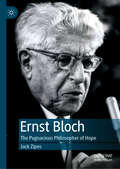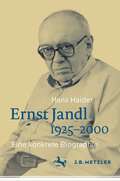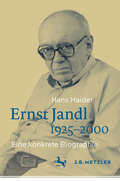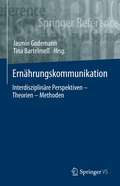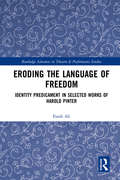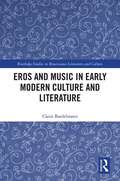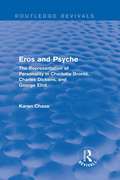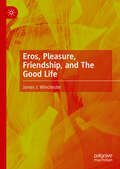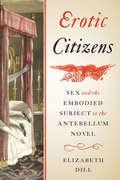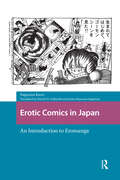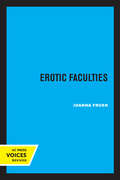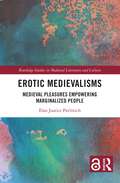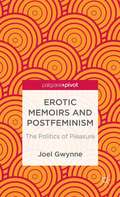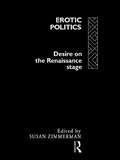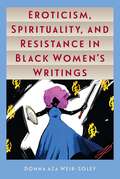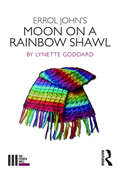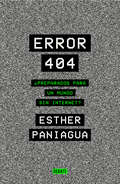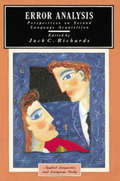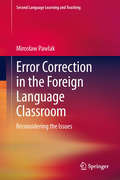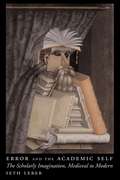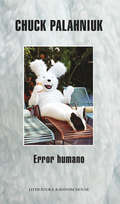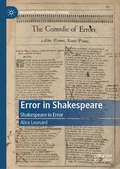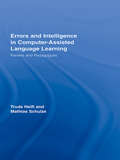- Table View
- List View
Ernst Bloch: The Pugnacious Philosopher of Hope
by Jack ZipesThis book provides a comprehensive introduction to and overview of the life and philosophy of Ernst Bloch. Bloch has had a strange fate in the English-speaking world. He wrote his famous three-volume opus, The Principle of Hope, while living in exile in the United States from 1938 to 1940. It was first published, however, in East Germany in the 1950s after he had returned to Europe and became a professor of philosophy at the University of Leipzig. Gradually, his other numerous works became better known and widespread in Europe and scholars in the US and UK started to take note of his works. Yet, he has still remained a somewhat neglected figure in the humanities. While this book does not set out to entirely rectify this neglect, it does offer readers an introduction to Bloch’s works and the opportunity to understand more about the importance of utopian thought. Through an exploration of some of Bloch’s more controversial communist leanings and relationship to the Soviet Union, a study of Bloch’s utopian quest, and even a comparison with J. R. R. Tolkien, this comprehensive study demonstrates just how interesting a figure Ernst Bloch really was, and how his philosophy of hope has laid the basis for secular humanism.
Ernst Jandl 1925–2000: Eine konkrete Biographie
by Hans HaiderErnst Jandl (1925–2000) gehört zu den wichtigsten Lyrikern des 20. Jahrhunderts. Mit Lettern- und Lautgedichten machte er sich in den 1950er Jahren in seiner Heimat Wien zum Außenseiter, fand jedoch rasch Anerkennung in den Zentren der Konkreten Poesie in Stuttgart, Prag, London. Wie ein Popstar entführte er bei lautstarken Auftritten die Jugend der Revolte-Generation mit Sprachwitz und -spiel in die Schmerzbezirke von Krieg, absurdem Alltag, Liebesdefizit. Er setzte dem hohen Ton eine „heruntergekommene“ Sprache und unterkühlten Dialekt entgegen. Mit der Lebenspartnerin Friederike Mayröcker schuf er Pionierwerke des ‚Neuen Hörspiels‘. Hans Haider legt nach Archivrecherchen in halb Europa und jahrzehntelanger Tätigkeit in der Wiener Kulturszene als Kritiker und Herausgeber die erste umfassende Jandl-Biographie vor.
Ernst Jandl 1925–2000: Eine konkrete Biographie
by Hans HaiderErnst Jandl (1925–2000) gehört zu den wichtigsten Lyrikern des 20. Jahrhunderts. Mit Lettern- und Lautgedichten machte er sich in den 1950er Jahren in seiner Heimat Wien zum Außenseiter, fand jedoch rasch Anerkennung in den Zentren der Konkreten Poesie in Stuttgart, Prag, London. Wie ein Popstar entführte er bei lautstarken Auftritten die Jugend der Revolte-Generation mit Sprachwitz und -spiel in die Schmerzbezirke von Krieg, absurdem Alltag, Liebesdefizit. Er setzte dem hohen Ton eine „heruntergekommene“ Sprache und unterkühlten Dialekt entgegen. Mit der Lebenspartnerin Friederike Mayröcker schuf er Pionierwerke des ‚Neuen Hörspiels‘. Hans Haider legt nach Archivrecherchen in halb Europa und jahrzehntelanger Tätigkeit in der Wiener Kulturszene als Kritiker und Herausgeber die erste umfassende Jandl-Biographie vor.
Ernährungskommunikation: Interdisziplinäre Perspektiven – Theorien – Methoden
by Jasmin Godemann Tina BartelmeßDer Band bietet einen umfassenden Überblick über den Stand der sozialwissenschaftlichen Ernährungsforschung: von interdisziplinären Perspektiven, über Kontexte und theoretische Bezüge bis hin zu verschiedenen methodischen Ansätzen, die an exemplarischen Studien veranschaulicht werden. Damit ist der Band in seiner wissenschaftlichen Ausrichtung sowie seiner thematischen Fokussierung auf Ernährungskommunikation einzigartig und bezieht aktuelle gesellschaftliche Diskurse und Herausforderungen mit ein.
Eroding the Language of Freedom: Identity Predicament in Selected Works of Harold Pinter (Routledge Advances in Theatre & Performance Studies)
by Farah AliLet down by the uncertainties of memory, language, and their own family units, the characters in Harold Pinter’s plays endure persistent struggles to establish their own identities. Eroding the Language of Freedom re-examines how identity is shaped in these plays, arguing that the characters’ failure to function as active members of society speaks volumes to Pinter’s ideological preoccupation with society’s own inadequacies. Pinter described himself as addressing the state of the world through his plays, and in the linguistic games, emotional balancing acts, and recurring scenarios through which he put his characters, readers and audiences can see how he perceived that world.
Eros and Music in Early Modern Culture and Literature (Routledge Studies in Renaissance Literature and Culture)
by Claire BardelmannWhat is the relationship between Eros and music? How does the intersection of love and music contribute to define the perimeter of Early Modern love? The Early Moderns hold parallel discourses on the metaphysical doctrines of love and music as theories of harmony. Statements of love as music, of music as love, and of both as harmonic ideals, are found across a wide range of cultural contexts, highlighting the understanding of love as a cultural construct. The book assesses the complexity of cultural discourses on this linkage of Eros and music. The ambivalence of music as an erotic agent is enacted in the controversy over dancing and reflected in the ubiquitous symbolism of music instruments. Likewise, the trivialization of musical imagery in madrigal lyrics and love poetry highlights a sense of degradation and places the love-music relationship at the meeting point of two epistemes. The book also shows the symbolic deployment of the intertwined ideas of love and music in the English epyllion, and offers close readings of Shakespeare’s poems The Rape of Lucrece and Venus and Adonis. The book is the first to propose an overview of the theoretical, cultural and poetical intersections of Eros and music in Early Modern England. It discusses the connections in a richly interdisciplinary manner, drawing on a wealth of primary material which includes rhetoric, natural philosophy, educational literature, medicine, music theory and musical performance, dance books, performance politics, Protestant pamphlets and sermons, and emblem books.
Eros and Psyche: The Representation of Personality in Charlotte Brontë, Charles Dickens, George Eliot (Routledge Revivals)
by Karen ChaseHow does Victorian fiction represent personality? How does it express emotion and how does it imagine the mind? These questions stand at the centre of Eros and Psyche, first published in 1984. In examining how three authors – Charlotte Brontë, Charles Dickens and George Eliot – depict the mind and organise emotion, Chase approaches their works as expressive structures, and analyses their struggle to accommodate rival imperatives in depicting personality: desire and duty, guilt and innocence, love and autonomy. The title begins with Brontë’s early Angrian tales, which introduce the problem that unifies the book: the attempt of Victorian fiction to escape the constraints of the romance mode, while assimilating its energies. There follow readings of The Pickwick Papers, Jane Eyre, Bleak House, and Middlemarch, in the light of such problems as confinement and exposure in Brontë, tragic doubt in Dickens, and the image of the moral mind in George Eliot.
Eros, Pleasure, Friendship, and The Good Life
by James J. WinchesterThe book invites its readers to explore the role erotic love, pleasure, and friendship play in crafting a good life. These topics are enduring themes that captures the heart of human existence, and have been the focus of many works of philosophy and literature. However, there remains scope for further examination. This book offers a compelling case to expand the exploration beyond the preponderance of white, male canonical figures that have dominated the field, in order to include an array of scholars that more accurately capture the diversity of humanity. It does so by drawing on Greek, Asian, Africana, Continental, and Feminist thinkers, and exploring a myriad of literary works to illustrate and interrogate the theories.
Erotic Citizens: Sex and the Embodied Subject in the Antebellum Novel
by Elizabeth DillWhat is the role of sex in the age of democratic beginnings? Despite the sober republican ideals of the Enlightenment, the literature of America’s early years speaks of unruly, carnal longings. Elizabeth Dill argues that the era’s proliferation of texts about extramarital erotic intimacy manifests not an anxiety about the dangers of unfettered feeling but an endorsement of it. Uncovering the more prurient aspects of nation-building, Erotic Citizens establishes the narrative of sexual ruin as a genre whose sustained rejection of marriage acted as a critique of that which traditionally defines a democracy: the social contract and the sovereign individual.Through an examination of philosophical tracts, political cartoons, frontispiece illustrations, portraiture, and the novel from the antebellum period, this study reconsiders how the terms of embodiment and selfhood function to define national belonging. From an enslaved woman’s story of survival in North Carolina to a philosophical treatise penned by an English earl, the readings employ the trope of sexual ruin to tell their tales. Such narratives advanced the political possibilities of the sympathetic body, looking beyond the marriage contract as the model for democratic citizenship. Against the cult of the individual that once seemed to define the era, Erotic Citizens argues that the most radical aspect of the Revolution was not the invention of a self-governing body but the recognition of a self whose body is ungovernable.
Erotic Comics in Japan: An Introduction to Eromanga (Asian Visual Cultures)
by Kaoru NagayamaComics and cartoons from Japan, or manga and anime, are an increasingly common feature of visual and popular culture around the world. While it is often observed that these media forms appeal to broad and diverse demographics, including many adults, eroticism continues to unsettle critics and has even triggered legal action in some jurisdictions. It is more urgent than ever to engage in productive discussion, which begins with being informed about content that is still scarcely understood outside small industry and fan circles. Erotic Comics in Japan: An Introduction to Eromanga is the most comprehensive introduction in English to erotic comics in Japan, or eromanga. Divided into three parts, it provides a history of eroticism in Japanese comics and cartoons generally leading to the emergence of eromanga specifically, an overview of seven themes running across works with close analysis of outstanding examples and a window onto ongoing debates surrounding regulation and freedom of expression in Japan.
Erotic Faculties
by Joanna FruehThe erotic and the intellectual come together to create a new kind of criticism in the lushly written work of Joanna Frueh. Addressing sexuality in ways that are usually hidden or left unsaid, Frueh—a noted performance artist and art historian—explores subjects such as aging, beauty, love, sex, pleasure, contemporary art, and the body as a site and vehicle of knowledge. Frueh's language is explicit, graphic, fragmented. She assumes multiple voices: those of lover, prophet, daughter, mythmaker, art critic, activist, and bleeding heart. What results is an utterly original narrative that frees us from the false objectivity of traditional critical discourse and affirms the erotic as a way to ease human suffering. Through personal reflection, parody, autobiography, and poetry, Frueh shows us what it means to perform criticism, to personalize critical thinking. Rejecting postmodern, deconstructed prose, she recuperates the sentimental, proudly asserts a romantic viewpoint, and disrupts academic and feminist conventions. Erotic Faculties seeks to free the power of our unutilized erotic faculties and to expand the possibilities of criticism; it is a wild ride and a consummate pleasure. This title is part of UC Press's Voices Revived program, which commemorates University of California Press’s mission to seek out and cultivate the brightest minds and give them voice, reach, and impact. Drawing on a backlist dating to 1893, Voices Revived makes high-quality, peer-reviewed scholarship accessible once again using print-on-demand technology. This title was originally published in 1996.
Erotic Medievalisms: Medieval Pleasures Empowering Marginalized People
by Elan Justice PavlinichErotic Medievalisms exposes modern apparatuses of oppression, reclaims histories for marginalized people, and promotes more inclusive representations in popular culture. Modern representations of the Middle Ages—including Santiago García and David Rubín’s graphic novel, Beowulf; Lil Nas X’s music video for "Montero (Call Me by Your Name);" Patience Agbabi’s retelling of Chaucer’s The Miller’s Tale, entitled "The Kiss;" and some BDSM (bondage and discipline, dominance and submission, sadism and masochism) practices—challenge pervasive power structures that privilege heterosexual male dominance commonly associated with medieval origins in popular culture. This comparative study between medieval and modern texts foregrounds the sexual gratification of people who are typically excluded from representations of the Middle Ages, specifically women, people of color, and LGBTQ+ individuals. Erotic displays of marginalized people in medieval contexts disrupt prevalent forms of oppression rooted in institutions that censor human experiences and direct sexual desires toward social justice.
Erotic Memoirs and Postfeminism: The Politics of Pleasure
by Joel GwynneThis book analyses the impact of postfeminist discourse and the mainstreaming of pornography on our understanding of intimacy and female sexuality. It is a broad critical survey of a recent publishing phenomenon - the female-authored erotic memoir - and positions the texts under analysis as complex and contradictory expressions of popular feminism.
Erotic Politics: The Dynamics of Desire in the Renaissance Theatre
by Susan ZimmermanIdentifying the stage as a primary site for erotic display, these essays take eroticism in Renaissance culture as a paradigm for issues of sexuality and identity in early modern culture. Contributors examine how the Renaissance stage functioned as a decoder for erotic experience, both reinforcing and subverting expected sexual behaviour. They argue that the dynamics of theatrical eroticism served to deconstruct gender definitions, leaving conventional categories of sexuality blurred, confused - or absent. In seeking to reposition the conventions and subversions of gender and desire in terms of one another, these essays open up an attractive and distinctive perspective in cultural debate.
Eroticism, Spirituality, and Resistance in Black Women's Writings
by Donna Aza Weir-Soley"Provocative . . . articulates the importance of embodied, erotic spirituality to black female subjectivity and empowerment."--Tulsa Studies in Women's Literature "Sets out to reclaim the right of black women to their sexual and erotic expression untainted by the stereotypes and disparagements that have historically confined them."--African American Review "Captures one of the most challenging concerns of scholars who engage black women's literature, culture, and theory: the ongoing quest to locate a form of black female sexual agency that neither withers in the chilly lake of sexual repression nor explodes in the heat of hypersexual stereotypes."--MELUS: Journal of the Society for the Study of the Multi-Ethnic Literature of the United States "Successfully undertakes an analysis of how black women writers have used overlapping narrative depictions of sexuality and spirituality to recast the denigrated black female body and rewrite an empowered and fully actualized black female subject."--Candice M. Jenkins, author of Private Lives, Proper Relations: Regulating Black Intimacy "Weir-Soley speaks with an authority that comes from real knowledge of, investment in, and attention to the details of the African cosmologies and textual complexities she unearths."--Carine Mardorossian, SUNY-Buffalo "The most original and significant contributions are the often brilliant readings of Morrison, Adisa, and Danticat. The work is riveting, both methodologically and critically."--Leslie Sanders, York University Western European mythology and history tend to view spirituality and sexuality as opposite extremes. But sex can be more than a function of the body and religion more than a function of the mind, as exemplified in the works and characters of such writers as Zora Neale Hurston, Toni Morrison, Opal Palmer Adisa, and Edwidge Danticat. Donna Weir-Soley builds on the work of previous scholars who have identified the ways that black women's narratives often contain a form of spirituality rooted in African cosmology, which consistently grounds their characters' self-empowerment and quest for autonomy. What she adds to the discussion is an emphasis on the importance of sexuality in the development of black female subjectivity, beginning with Hurston's Their Eyes Were Watching God and continuing into contemporary black women's writings. Writing in a clear, lucid, and straightforward style, Weir-Soley supports her thesis with close readings of various texts, including Hurston's Their Eyes Were Watching God and Morrison's Beloved. She reveals how these writers highlight the interplay between the spiritual and the sexual through religious symbols found in Voudoun, Santeria, Condomble, Kumina, and Hoodoo. Her arguments are particularly persuasive in proposing an alternative model for black female subjectivity.
Erotics of Sovereignty: Queer Native Writing in the Era of Self-Determination
by Mark RifkinIn 1970 the Nixon administration inaugurated a new era in federal Indian policy. No more would the U.S. government seek to deny and displace Native peoples or dismantle Native governments; from now on federal policy would promote &“the Indian&’s sense of autonomy without threatening his sense of community.&” In The Erotics of Sovereignty, Mark Rifkin offers a telling perspective on what such a policy of self-determination has meant and looks at how contemporary queer Native writers use representations of sensation to challenge official U.S. accounts of Native identity. Rifkin focuses on four Native writers—Qwo-Li Driskill (Cherokee), Deborah Miranda (Esselen), Greg Sarris (Graton Rachería), and Chrystos (Menominee)—approaching their fiction and poetry as forms of political theory. Rifkin shows how the work of these queer or two-spirit Native writers affirms the significance of the erotic as an exercise of individual and community sovereignty. In this way, we come to see how their work contests the homophobic, sexist, and exclusivist policies and attitudes of tribal communities as well as those of the nation-state.
Errol John's Moon on a Rainbow Shawl (The Fourth Wall)
by Lynette GoddardErrol John wrote Moon on a Rainbow Shawl (1958) after becoming disillusioned about the lack of good roles for black actors on the British theatre scene. While this situation has only slightly improved since, his response has become the most revived black play in Britain, from its original production at the Royal Court in 1958, to the National Theatre in 2012. It depicts the lives of a black community living in poverty in a shared tenement yard in Port of Spain, Trinidad, in the mid-1940s, showing how each of the characters carries dreams of escaping to create better lives for themselves and their families. Lynette Goddard focuses on how the play articulates the narratives of migration that prompted many Caribbean people to uproot from their homes on the islands and move to the England in the post-war era. For some of them, these dreams of a new life became a reality, but they were experienced differently across genders and generations.
Error 404: ¿Preparados para un mundo sin internet?
by Esther PaniaguaEs cuestión de tiempo que la red caiga. ¿Estamos preparados? Error 404 no es una distopía. Es un impactante ensayo que trata de anticiparse a ella antes de que sea demasiado tarde. Es cuestión de tiempo que la red caiga. Internet se vendrá abajo y viviremos oleadas de pánico. ¿Suena apocalíptico? No lo es. En Error 404, Esther Paniagua aborda las múltiples formas en las que internet se está cayendo y cómo podría producirse un gran apagón de la red de redes; el caos que ello podría desatar y lo dependientes que somos de ella. Desvela quiénes son los guardianes de internet y nos abre la puerta al lado más oscuro del ciberespacio para hablar de crimen y adicción; de quién convirtió el beicon con huevos en el desayuno estadounidense por excelencia y qué tiene eso que ver con la manipulación; de desinformación, polarización y odio incendiario online; de cómo se ha automatizado la discriminación así como de censura y represión. En definitiva, nos muestra el funcionamiento oculto de una tiranía digital que George Orwell o Aldous Huxley tan siquiera imaginaron. ¿Cómo hemos llegado hasta aquí? ¿Qué se oculta en las tinieblas de internet?¿Hay esperanza de un nuevo amanecer? ¿Seremos capaces de cambiar el rumbo? Error 404 no es una distopía. Es un impactante ensayo que trata de anticiparse a ella antes de que sea demasiado tarde. Estas páginas analizan los temas de ahora, tan urgentes como cruciales, con una perspectiva crítica y propositiva, pues, tal y como defiende su autora, a pesar de todo aún hay motivos para la esperanza. Reseñas:«Una llamada urgente y necesaria a reimaginar y rediseñar radicalmente internet por el bien global.»María Sefidari, presidenta de Fundación Wikimedia. «Un diagnóstico clarificador, preciso y sintético del presente como herramienta para crear el futuro. Se lee como una novela.»Mario Tascón, socio director de Prodigioso Volcán. «Un terrorífico relato sobre el fin del mundo, tan preciso y bien documentado que ya nunca volverás a ver internet del mismo modo.»Toni García, periodista. «Cuando juntas mentes brillantes suceden cosas brillantes. Pero cuando conectas a Esther Paniagua con las personas que más han cambiado nuestras vidas y el mundo… eclosiona este libro de lectura obligatoria para los que nos proponemos seguirlo cambiando.»Andreu Vèa, el biógrafo de internet.
Error Analysis: Perspectives on Second Language Acquisition (Applied Linguistics and Language Study)
by Jack C. RichardsThe eleven essays in this book cover a wide range of topics from the role of 'interlanguage' and the influence of external factors on the process of language learning, to the development of syntax and the methodology of error analysis. Collectively they provide a valuable perspective on the learning process, which both enriches our theoretical understanding of the processes underlying second language acquisition and suggests ways in which teaching practice may best exploit a learner's skills.
Error Correction in the Foreign Language Classroom: Reconsidering the Issues
by Mirosław PawlakThe book aims to dispel some of the myths surrounding the place of oral and written error correction in language education by providing an exhaustive and up-to-date account of issues involved in this area, taking the stance that the provision of corrective feedback constitutes an integral part of form-focused instruction. This account places an equal emphasis on the relevant theoretical claims, the most recent research findings and everyday pedagogical concerns, particularly as they apply to the teaching of additional languages in the foreign language setting. The book will be of relevance and significance not only to specialists in the field of second language acquisition, but also to graduate and doctoral students carrying out research in the area of form-focused instruction and error correction. Many parts of the volume will also be of considerable interest and utility to teachers of foreign languages at different educational levels.
Error and the Academic Self: The Scholarly Imagination, Medieval to Modern
by Seth LererExamining figures from Thomas More to Stephen Greenblatt, from George Hickes to Seamus Heaney, from George Eliot to Paul de Man, this book illuminates the wanderings of exiles, émigrés, dissenters, and the socially estranged as they helped form the modern university disciplines of philology and rhetoric, literary criticism and literary theory.
Error and the Academic Self: The Scholarly Imagination, Medieval to Modern
by Seth LererHow and why did the academic style of writing, with its emphasis on criticism and correctness, develop? Seth Lerer suggests that the answer lies in medieval and Renaissance philology and, more specifically, in mistakes. For Lerer, erring is not simply being wrong, but being errant, and this book illuminates the wanderings of exiles, émigrés, dissenters, and the socially estranged as they helped form the modern university disciplines of philology and rhetoric, literary criticism, and literary theory. Examining a diverse group that includes Thomas More, Stephen Greenblatt, George Hickes, Seamus Heaney, George Eliot, and Paul de Man, Error and the Academic Self argues that this critical abstraction from society and retreat into ivory towers allowed estranged individuals to gain both a sense of private worth and the public legitimacy of a professional identity.
Error humano
by Chuck PalahniukUna antología de crónicas, retratos e historias por el autor de El club de la lucha Compendio de crónicas, retratos de estrellas e historias íntimas, Error humano nos permite entrever el insólito mundo del autor y nos invita a destapar algunas de las realidades más sórdidas que alimentan sus novelas. Destacan en este universo el capítulo "Combate de cosechadoras", una crónica sobre la América profunda donde se mezclan el absurdo y la aberración, el retrato de un Marilyn Manson que habla sin tapujos de sí mismo a través de una sesión de tarot o la curiosa descripción del rodaje de El club de la lucha, en la que se habla del potenciador de labios de Brad Pitt. Reseñas: «Tal vez nuestra generación haya encontrado otro Don DeLillo.» Bret Easton Ellis «Como Edgar Allan Poe, Palahniuk es un incansable proveedor tóxico de un creciente horror. En su caso, convierte el nihilismo en diversión.» Henry Alford, Vanity Fair «Palahniuk siempre ha dicho que sus libros son mera observación y, cuando uno lee sobre los lugares a los que va y la gente a la que conoce, es fácil creerlo.» Alice Fisher, Time Out London
Error in Shakespeare: Shakespeare in Error (Palgrave Shakespeare Studies)
by Alice LeonardThe traditional view of Shakespeare’s mastery of the English language is alive and well today. This is an effect of the eighteenth-century canonisation of his works, and subsequently Shakespeare has come to be perceived as the owner of the vernacular. These entrenched attitudes prevent us from seeing the actual substance of the text, and the various types of error that it contains and even constitute it. This book argues that we need to attend to error to interpret Shakespeare’s disputed material text, political-dramatic interventions and famous literariness. The consequences of ignoring error are especially significant in the study of Shakespeare, as he mobilises the rebellious, marginal, and digressive potential of error in the creation of literary drama.
Errors and Intelligence in Computer-Assisted Language Learning: Parsers and Pedagogues (Routledge Studies in Computer Assisted Language Learning)
by Mathias Schulze Trude HeiftThis book provides the first comprehensive overview of theoretical issues, historical developments and current trends in ICALL (Intelligent Computer-Assisted Language Learning). It assumes a basic familiarity with Second Language Acquisition (SLA) theory and teaching, CALL and linguistics. It is of interest to upper undergraduate and/or graduate students who study CALL, SLA, language pedagogy, applied linguistics, computational linguistics or artificial intelligence as well as researchers with a background in any of these fields.
